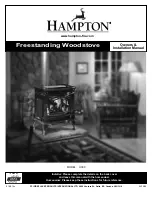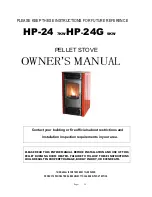
17
ENGLISH
06.2
RECOMMENDED FUELS
A pellet product’s performance is significantly linked and highly influenced by the type and quality of wooden pellets that is burned. It is
important to choose pellets that have no debris or impurities. The Association of Pellet Manufacturers with the Italian Thermotechnical
Committee have established standards for identifying pellets in terms of energy*.
As the efficiencies of different wooden PELLETS qualities differ, likewise the efficiency and heat capacity emitted by the product running
on pellets will vary. Similarly, unburned residue left in the combustion chamber is inversely proportionate to pellet quality: the lower the
pellet purity, the faster dirt accumulates in the machine.
Jolly Mec Caminetti S.p.A strongly recommends the use of the same type of pellets used during first start-up, i.e. when the settings and
calibrations were made to suit the loaded combustible materials. Continuous switching of types and qualities of combustible materials
will require continuous adjustments to settings by the Technical Assistance Centre, which can not be endorsed by the Manufacturer.
The main quality certifications for PELLETS on the European market are DIN Plus, Ö-Norm M7135 and UNI EN ISO 17225-2 (class A1
or A2), which guarantee the following quality standards:
Store pellets at least 1 m from the appliance, in a dry place and not outdoors, not even under porches or roofings.
Do not use pellets that are very hard and with different dimensions; the mechanical parts are sized and tested for use with pellets with
the above-mentioned characteristics.
No breakdown or malfunction depending on the quality of the pellets used and/or by the dosage of the quantity will be covered
by the warranty.
PELLET QUALITY IS VERY IMPORTANT; PLEASE READ THIS SECTION CAREFULLY
WARNING
*CERTIFIED PELLET CHARACTERISTICS
Powder
1% maximum through a 3.2 mm screen
Apparent density
680 Kg/m
3
minimum
Dimensions
6 mm diameter from 25 to 30 mm of maximum length
Ash content
1% maximum
Humidity
8% maximum
Heating power
4,9 kWh/Kg
Packaging
in eco-compatible or biodegradable material sacks
WHAT YOU SHOULD KNOW ABOUT PELLETS:
pellets are obtained by a drawing process using sawdust discarded by virgin wood processing systems and therefore
have no chemical additives. The consistency, compactness and strength with which the pieces remain intact is due to a
substance contained in wood called lignin; this acts as a binder during the compression phase.
The various qualities of combustible materials can also depend on the sawdust mix used to produce the pellets, which
generally have a standard length of between 5 and 30 mm, a diameter of between 5 and 6 mm, a weight of from 600 to
700 Kg/m
3
and a humidity of no more than 8% of its weight.
One advantage over wood is its greater heating power; in fact, when using good quality wood, it is possible to achieve
about 4.3kWh/Kg with a humidity rate of up to 15%, whilst with pellets this can climb to 4.9kWh/Kg and a water content
of a maximum of 8%.
The sacks of pellets must be stored in a clean, dry place.
NOTE
















































